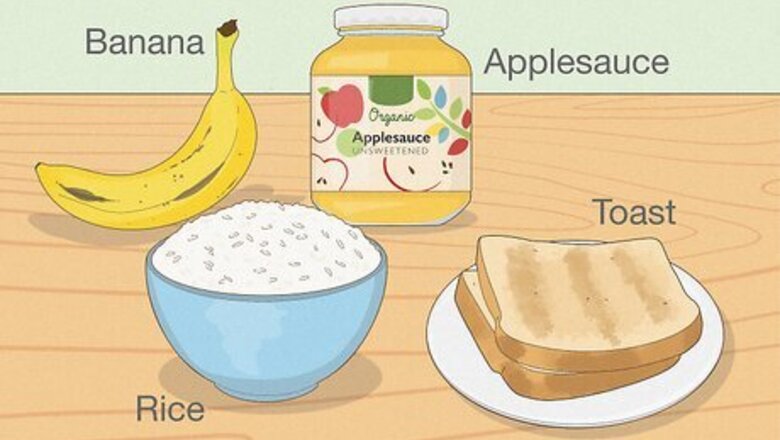
views
X
Research source
Barr, Wendy, and Andrew Smith, Acute Diarrhea in Adults, American Family Physician, 2014 Feb 1, 89(3), 180-189
One of the most popular ways to treat diarrhea is the BRAT method, which is a food-based home remedy.
Using the BRAT Method
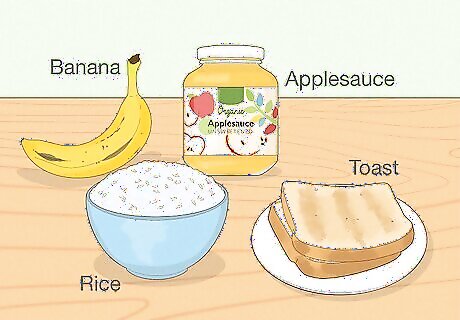
Use the BRAT method to treat short-term diarrhea. Physicians often recommend the BRAT method when someone is suffering from acute diarrhea, which is diarrhea that lasts for less than 14 days. This method, which is a diet of bland foods incorporated into your diet, helps settle your stomach and helps you recover from a gastrointestinal infection that causes diarrhea. BRAT stands for bananas, rice, applesauce, and toast. These foods are typically recommended because they are easy to digest, are well tolerated by most people, and low in fiber to help firm up stools. This is not a weight loss method and is not recommended for the long term. This diet is low in protein, fat, and fiber and lacks key nutrients needed to live over time. Only use this method for the few days it takes to be able to stomach normal food when you have diarrhea. Make sure you stick to it for at least 24 hours to help with your symptoms. The major concern that doctors have about the BRAT diet is that it is unnecessarily restrictive and doesn't provide the nutrition you need to recover from an illness. If you have any questions about whether you should use this approach, talk to your doctor.
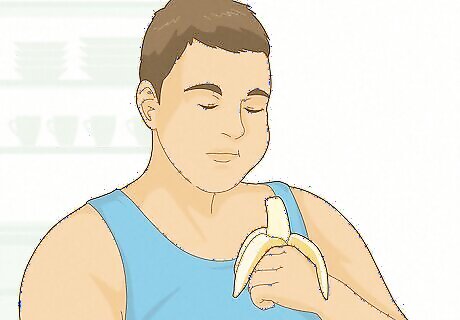
Eat bananas. The first step in the BRAT method is to eat bananas. Bananas are great when you are suffering from diarrhea because they are bland and easy on the stomach. They are also helpful because they are rich in potassium, which will help counter the loss of nutrients from diarrhea. Eat plenty of bananas while you are suffering from diarrhea. Do not over eat yourself and cause more stomach issues. Only eat what you can without making yourself sick. Bananas contain about 422 mg of potassium making bananas a potassium-rich superfood with 13% of the RDA of potassium in one banana. Potassium is an important electrolyte responsible for providing energy for the cells, tissues, and organs of the body. Green bananas are preferable due to the increased amounts of pectin.

Cook white rice. While rice is a great, bland starch that can easily be tolerated when your stomach is upset. Eat it by itself without added butter or salt. The extra ingredients may upset your stomach even more, especially in the first few days of diarrhea. Don't eat brown rice. Brown rice has increased fiber, which can make your stools loose and may make your diarrhea worse.

Consume more applesauce. Applesauce is also bland but also has added sweetness and natural sugars. This is easily digested and easy to tolerate, even if your stomach is upset. You can buy individual applesauce cups for ease or large jars of applesauce to serve in bowls. Eat multiple servings of applesauce a day to help your calorie intake and keep your stomach settled. Avoid buying the flavored types of applesauce because they have increased sugar content and may upset your stomach more. One concern is that doctors have is the consumption of simple sugars. Simple sugars, like the sugars contained in applesauce, increase stool output and are low in sodium and potassium, which are key electrolytes of the body.
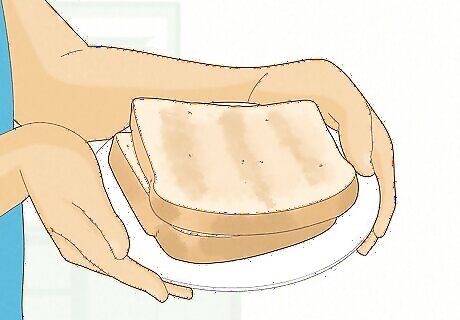
Make toast. One of the blandest foods you can eat is plain bread. It is a good source of bland carbohydrates that are easy to digest when your stomach is upset. White bread is better because the flavor is milder and there is less fiber and will help firm up your stools. Avoid putting butter and sugary jams on your toast. Butter is high in fat and sugary jams can make your stomach worse.
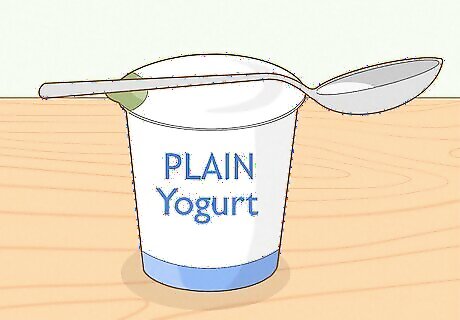
Try variations in the method. There are two common variations in the BRAT method. There is the BRATY method, which adds yogurt to the method. Plain yogurt has increased potassium and good bacteria for your system. You can also try the BRATT method, which adds tea to the routine. Gentle herbal teas can help keep you hydrated and settle your stomach. You can combine them all to make the BRATTY method if you think all the different components work for you. You could also use the low-residue diet, which encourages you to eat more starchy carbs, some protein, and less fiber and dairy.

Shift your approach with children. In recent years, there are some doctors that believe the BRAT diet may be too restrictive for children with acute diarrhea because it lacks the nutrients their bodies need to get better. These doctors suggest this diet in the first 24 hours of the condition. After this period, they recommend adding in more nutrient-rich foods from the children's normal diet while avoiding foods with simple sugars. These include soda, juice, gelatin desserts, or other highly sugared foods, which may worsen the diarrhea. Once the illness is over, children should receive additional nutrition to compensate for any nutritional deficiency that arose during the illness. Certain guidelines have recommended avoiding fatty foods, but maintaining adequate calories without fat is difficult, and fat might have a beneficial effect of reducing intestinal motility. Instead, don't give your child overly greasy foods with small amount of nutrients in them. Try to make them eat the foods of the BRAT method in the first 24 hours, even if it is in small doses to avoid them getting sick. The somewhat common practice of withholding food when diarrhea is first developed is inappropriate. Early feeding decreases changes in intestinal permeability caused by infection, which can reduce the duration of the illness duration and improves the outcome. Doctors recommend an age-appropriate diet with complex carbohydrate, lean meats, yogurt, fruit, and vegetables. These are better tolerated than fats and simple sugars.

Get potassium elsewhere. If you do not like bananas or want to get your potassium from other sources while you are sick, there are many additional bland foods that can provide potassium for you. White beans, baked potatoes with skin, dried apricots, and avocados are great sources of potassium and can help you recuperate during bouts of diarrhea. Only eat these foods if you think your stomach is ready for them. You don't want to upset your system even more than it already is.
Avoiding Dehydration
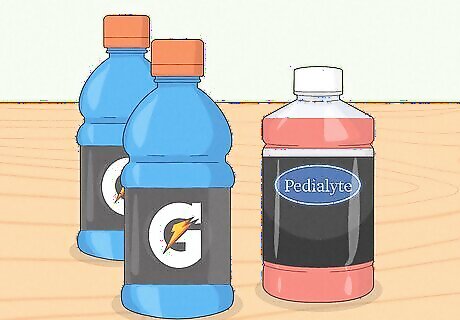
Drink plenty of fluids. No matter what diet method you try while you have diarrhea, you need to stay hydrated. One of the major side effects of diarrhea is dehydration due to the continual loss of nutrients and fluids from the body. You need to continually replace these losses with electrolytes. Try drinking electrolyte-rich drinks such as Gatorade and Pedialyte along with plenty of water. Electrolytes such as potassium are key to keeping you safe and healthy as you work through your sickness. Dehydration is more common with diarrhea than other stomach issues because the colon absorbs electrolytes and water, but when it is inflamed like it is when you have diarrhea, the colon cannot do either. Make sure you pay extra close attention to your hydration during the first few days of your diarrhea. This is when you lose most of your fluids. Drink at least 64 oz of water a day or 8 eight oz glasses. Drinks with caffeine do not count toward the daily total of water consumption.
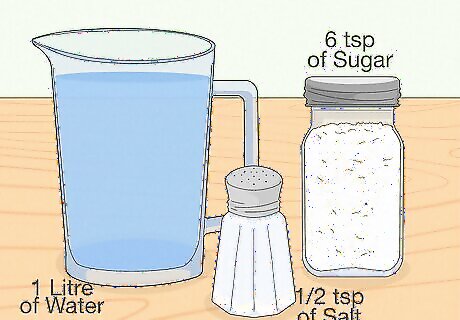
Make a homemade rehydration solution. There are some homemade mixtures you can make to help with rehydration. Take one liter of water and add 6 teaspoons of sugar and 1/2 a teaspoon of salt. Drink one teaspoon of this solution every 5 minutes.
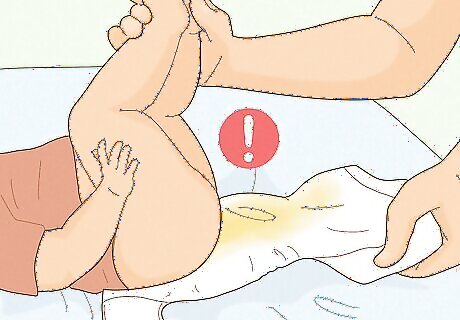
Notice signs of dehydration in children. There are some groups who are more at risk for dehydration than others. Infants and toddlers are at an increased risk of dehydration when suffering from diarrhea. Watch infants, toddlers, and children for symptoms such as crying without tears, decreased urine in diapers or urinary output, and sunken eyes or fontanels. If you notice these signs, seek medical attention. Dehydration can be serious and require intravenous fluid replacement. Babies being breastfed can still be breastfed when suffering from diarrhea.
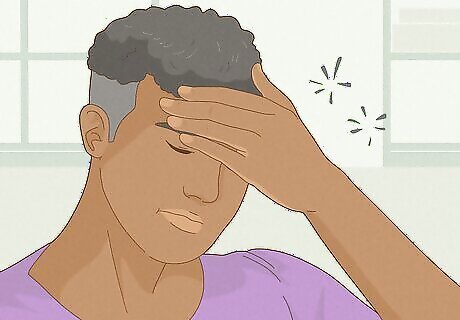
Recognize dehydration symptoms in adults. Any adult can become dehydrated while suffering from diarrhea. Groups of people such as diabetics, the elderly, or those with HIV are at higher risk of dehydration. Look for symptoms such as dizziness when standing, a racing pulse with standing, dry oral mucosa, or feeling very weak. All the cells in our bodies run on what is termed the sodium-potassium pump, so losses of these minerals are critical, especially potassium. This can cause serious problems, including sudden cardiac death. If you are unable to tolerate oral fluids, keep a close watch on yourself. You may need to go to the emergency room to get IV fluids and electrolytes if you can't rehydrate on your own. You should go to the the ER if you are having nausea and vomiting associated with your diarrhea such that you cannot keep down liquids.













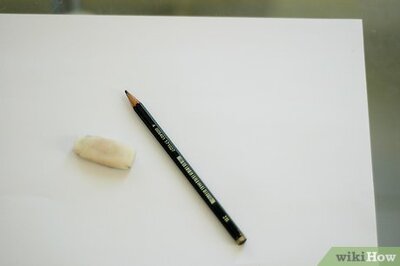

Comments
0 comment